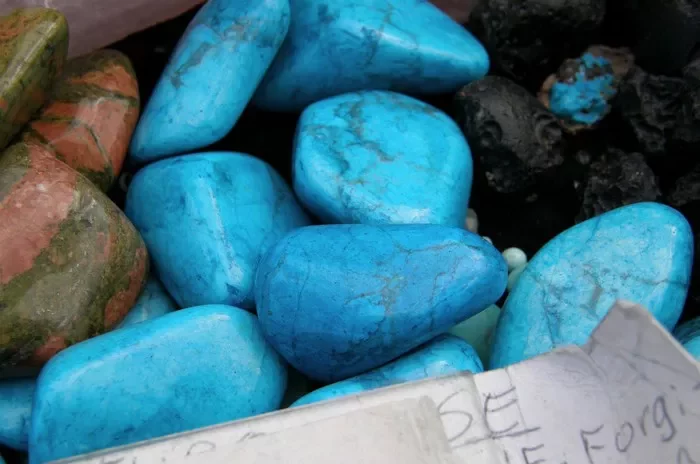Turquoise, a gemstone cherished for its captivating hues, holds a significant place in the world of jewelry and culture. Its name, derived from the French word “turquois,” meaning “Turkish stone,” reflects its historical association with trade routes through Turkey. Revered for millennia, turquoise boasts a rich history steeped in cultural significance and symbolic meanings.
Ancient civilizations, including the Egyptians, Persians, and Native Americans, revered turquoise for its perceived mystical properties and aesthetic allure. Often associated with protection, wisdom, and spiritual healing, turquoise adorned royalty, warriors, and shamans alike. Its vibrant shades of blue and green evoke images of clear skies and tranquil waters, making it a cherished gemstone in various cultures across the globe.
Precious vs. Semiprecious Classification
Gemstones have long been categorized into two broad classes: precious and semi-precious. This classification serves as a framework for organizing and valuing gemstones, though it’s essential to recognize its subjective nature.
The distinction between precious and semi-precious gemstones is not solely based on inherent qualities like beauty or durability. Instead, it reflects historical conventions and cultural perceptions. Precious gemstones historically included diamonds, rubies, sapphires, and emeralds, primarily due to their rarity, hardness, and association with royalty and wealth.
In contrast, semi-precious gemstones encompass a vast array of gems beyond the “big four.” This category includes gems like amethyst, citrine, garnet, and, indeed, turquoise. While these gems may lack the rarity or price tag of their precious counterparts, they possess their own unique allure and cultural significance.
Turquoise as a Semiprecious Stone
Turquoise, with its mesmerizing hues and unique properties, falls under the category of semiprecious gemstones. Renowned for its striking greenish-blue or sky-blue coloration, turquoise exhibits an opaque appearance that sets it apart from other gemstones. Composed primarily of hydrated phosphate of copper and aluminum, turquoise derives its distinctive color from the presence of copper compounds within its structure.
One of turquoise’s defining characteristics is its cryptocrystalline structure, which means that its crystalline elements are so fine that they cannot be seen with the naked eye. This structure contributes to turquoise’s smooth texture and waxy luster, enhancing its appeal in jewelry and decorative arts.
Technical Details
In technical terms, turquoise is defined by its chemical composition, Mohs hardness, and crystal structure. Chemically, turquoise is composed of hydrated phosphate of copper and aluminum, represented by the formula CuAl₆(PO₄)₄(OH)₈·4H₂O. This composition gives turquoise its vibrant color and unique properties.
On the Mohs scale of mineral hardness, turquoise typically ranges from 5 to 6, making it relatively soft compared to precious gemstones like diamonds and sapphires. While this may affect its durability, turquoise’s beauty and appeal remain undiminished, especially when properly cared for.
Crystallographically, turquoise exhibits a cryptocrystalline structure, consisting of microscopically small crystals that are densely packed together. This structure contributes to turquoise’s smooth texture and lends itself well to various forms of jewelry and ornamentation.
Allure of Turquoise
Despite its classification as a semiprecious gemstone, turquoise possesses an undeniable allure that transcends its monetary value. Its mesmerizing blue-green shades evoke images of serene waters and boundless skies, making it a sought-after gemstone for both artisans and collectors alike.
One of the most remarkable aspects of turquoise is its rich cultural history. Revered by ancient civilizations such as the Egyptians, Persians, and Native Americans, turquoise has been used for millennia in religious rituals, protective amulets, and ornamental jewelry. Its significance varies across cultures, with some attributing healing properties to turquoise and others regarding it as a symbol of prosperity and protection.
In addition to its historical and cultural significance, turquoise continues to captivate modern audiences with its timeless beauty. From statement necklaces to delicate earrings, turquoise jewelry adds a pop of color and sophistication to any ensemble. Its versatility allows it to be paired with various metals and gemstones, creating striking combinations that appeal to a wide range of tastes and preferences.
Turquoise in the Market
While turquoise may not command the same exorbitant prices as some precious gemstones, its value should not be underestimated. Factors such as color intensity, clarity, and size influence the price of turquoise, with high-quality specimens fetching premium prices in the market.
One of the factors contributing to turquoise’s accessibility is its abundance in nature. Deposits of turquoise can be found in regions such as the United States, Mexico, Iran, and China, ensuring a steady supply for both commercial and artisanal purposes. This widespread availability allows turquoise to cater to a diverse clientele, from connoisseurs seeking rare collector’s pieces to everyday consumers looking for affordable yet elegant jewelry options.
Furthermore, the perceived value of turquoise extends beyond its monetary worth. Its intrinsic beauty and cultural significance imbue it with a sense of value that transcends market fluctuations. Whether adorning a royal crown or a handmade bracelet, turquoise holds a special place in the hearts of those who appreciate its unique allure.
Preserving the Beauty of Turquoise
To ensure the longevity of turquoise jewelry, proper care and maintenance are essential. Due to its relatively moderate hardness, turquoise is susceptible to scratches and chipping if subjected to rough handling or abrasive surfaces. Therefore, it is advisable to store turquoise jewelry separately from harder gemstones to prevent damage.
Additionally, turquoise should be shielded from harsh chemicals and extreme temperatures, as these can cause discoloration or deterioration of the stone. Cleaning turquoise jewelry with a soft, damp cloth and mild soap is recommended to remove dirt and oils without compromising its natural beauty.
Furthermore, periodic re-polishing by a professional jeweler can help restore the luster of turquoise jewelry and maintain its pristine appearance over time. By following these simple maintenance tips, turquoise enthusiasts can enjoy their cherished pieces for generations to come.
In conclusion, turquoise stands as a shining example of a semiprecious gemstone that captivates hearts and minds with its beauty and cultural significance. While its classification may place it alongside other semiprecious stones, turquoise’s allure remains undiminished, making it a cherished gemstone for generations to come.


